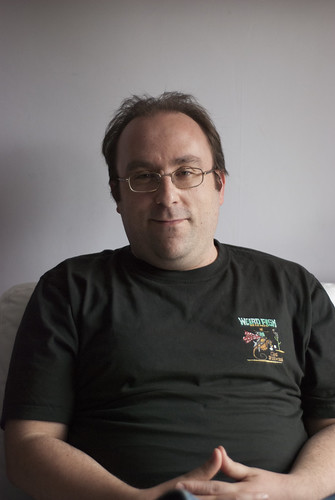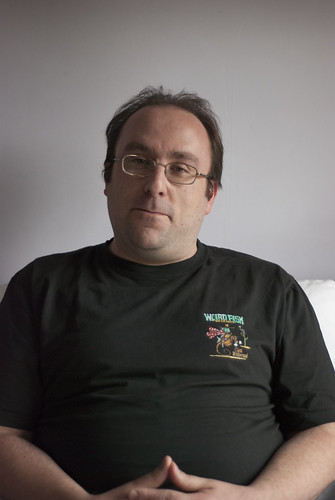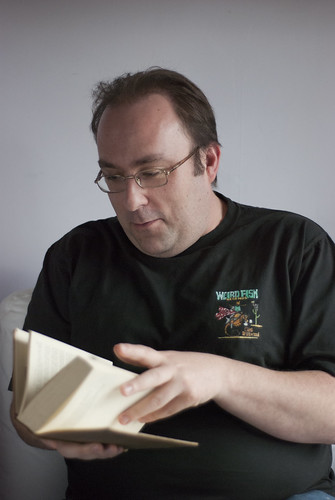Where: At home, Indoors
When: In the afternoon, just after about 2.pm. when the sun was high enough in the sky to provide light into the room but not directly and it was cloudy enough that the light was diffused.
How: I started this exercise by reviewing some material in the book – The Portrait Photography Course by Mark Jenkinson. One of the points made in the book is to understand the use of shadow in portraiture, and in the case of this exercise I decided that I did not want a lot of shadow and that I really wanted to keep the image as simple as possible as I did not want to present myself with too many problems.
I had over complicated things by waiting for a good sunny day to do an outdoor photography session, but after waiting for two weeks for the right weather I got fed up and had Mark and Ali (my subjects/models) turn up and we would see if we could just photograph indoors. As Mark and Ali arrived, the weather did brighten up a little, but when I checked with a small hand held light meter I found that there was little difference in the amount and colour of the light outside compared to inside the house.
I set up the camera on a tripod and had Lindsay act as an assistant; holding a large white reflector off to the side of the seating position to fill as a fill light. I had a short shutter release cable attached to the camera which meant that I could move a little from the camera and not worry about how I was going to activate the shutter. This allowed me a little more freedom when I was photographing as I could swap hands as well as move away from the eyepiece. It also allowed me to check if the camera was positioned correctly. I did not want the portrait to be overly superior or diminutive so I took a while raising and lowering the camera until I felt I had the dominant eye in the right position.
After discussing what I wanted with Mark and then working through Lindsay and Ali to translate from English to Italian and back to English, Mark sat in position on the sofa. To begin with both he and I were quite nervous and I found myself telling him to relax, which did not help. I then stopped and had a short chat with Mark and while we talked I used my remote shutter to trigger a few frames through. Mark instantly reacted to the sound and we found that he put on his “photo” face and smiled directly into the camera. We took a short break and I asked him not to react to the sound of the shutter but instead ignore it and listen to my instructions instead. I then stuck a spare card into the camera and just randomly shot for a while in an attempt to stop Mark reacting to the shutter.
While I was instructing him, I started to talk to him about books he was reading at the moment and this helped to relax him. We spoke for a while and I gained his confidence when, after swapping to the card I wanted to use, I photographed him and then showed him the result on the camera screen. As I spoke to Mark, I moved away from the camera and tripod and went left, right, above and below the camera lens directing him to look in certain directions. I found that I could not get him to react to certain questions and directions as the translation took too long to perform and he had moved away from the expression or stance. Eventually I found a book, and had him read some passages from it as it focussed his attention away from the sound of the camera. I then continued to photograph him, while distracting his attention and used Ali as a distraction to help guide Mark, but in the end I ended up taking more photographs than necessary as every so often he would start to respond with his “photo” face again. While I was not looking for a deadpan expression from Mark I was hoping to achieve a number of natural photographs where I could get definitive shots of differing eye lines. As soon as I started to review the images I threw away about three quarters of them as they were unusable; Most of them were due to Mark reacting to the camera or moving too fast and blurring the image. While I was happy with the quality and colour of the light and the fill from the reflector I was not happy with the way the session had progressed, I found that I myself was quite nervous and in fact having Lindsay and Ali there as well was a bit of a hindrance as Mark would converse with them and not pay full attention to when I was directing him.
Looking into the Lens 1
Nikon D80, focal length 50.0mm (35mm equivalent 75mm), aperture f1.8, speed 1/750 second, ISO 500, Shade white balance, Spot metering, Tripod Mounted camera, 50mm lens, No flash.

Looking into the Lens 2
Nikon D80, focal length 50.0mm (35mm equivalent 75mm), aperture f1.8, speed 1/1000 second, ISO 500, Shade white balance, Spot metering, Tripod Mounted camera, 50mm lens, No flash.

Looking Right
Nikon D80, focal length 50.0mm (35mm equivalent 75mm), aperture f1.8, speed 1/500 second, ISO 500, Shade white balance, Spot metering, Tripod Mounted camera, 50mm lens, No flash.

Looking Down
Nikon D80, focal length 50.0mm (35mm equivalent 75mm), aperture f1.8, speed 1/1000 second, ISO 500, Shade white balance, Spot metering, Tripod Mounted camera, 50mm lens, No flash.

Slightly Up
Nikon D80, focal length 50.0mm (35mm equivalent 75mm), aperture f1.8, speed 1/1000 second, ISO 500, Shade white balance, Spot metering, Tripod Mounted camera, 50mm lens, No flash.

One thing I got out of this exercise was that it takes quite a bit of preparation work to get a good session and that with practise I should get better at directing people. I think that better notes and samples of what I am trying to achieve would also help as sometime I did struggle to find the right words and instructions when directing.
Having looked over the images and looking back at the day I have realised that I was not able to get Mark to feel comfortable and that there may be problems to overcome where the subject may have a weak chin, deep set eyes or receding hairline.
No comments:
Post a Comment